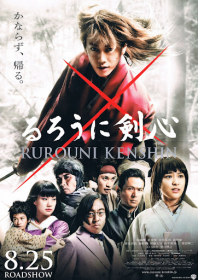
Nobuhiro Watsuki’s popular 90s manga gets the live-action treatment with fight scenes orchestrated by long-time Donnie Yen collaborator, Kenji Tanigaki. Japan, 1868, and the Battle of Toba-Fushimi marks the end of shogunate rule and the start of the Meiji period, when Japanese isolationism was replaced by a new age of modernism, openness and industry. At the end of the battle, when it’s clear that Japan’s feudalistic system is over, legendary pro-government killer Himura Battōsai (Takeru Satoh) – forever marked with a distinctive facial scar – stabs his katana into the ground and walks away from the bloodshed, becoming ‘Himura Kenshin’, a wandering swordsman who will now only use his martial arts abilities for good. To doubly make sure that he won’t just impulsively take someone’s head off, he carries a sakabatō – a katana with the cutting edge on the inside. He befriends idealistic orphan girl, Kaoru (Emi Takei), owner of an empty Tokyo kendo school who shares Kenshin’s belief that a sword shouldn’t be used for taking a life, but for protecting it. Conflict arrives in the form of rich, creepy imperialist, Kanryū (Teruyuki Kagawa), who plans to use his new opium recipe to cripple the country and take over the world. Kanryū and his cronies represent the greedy, corrupted excesses of the new world, but the film also acknowledges the remnants of the old ways; from the starving, desperate ronin forced to make a living as bandits and scroungers, to the neatly uniformed police force made up of former, battled-hardened Samurai. (The most enigmatic being the chain-smoking Saitō Hajime, played by Yōsuke Eguchi, who looks more like a rock star than a copper). The film also dabbles in the supernatural with a subplot involving an eerily possessed ronin capable of Jedi-like mind powers, eager to do battle with Kenshin and bring out his ‘dark-side’. For a manga adaptation, it’s not half as mad as you might expect; it’s played mostly straight, nuanced, and at times bordering on the profound. Don’t expect any of Tanigaki’s Hong Kong-style MMA-tinged fist-fights – think more Kamui than Kill Zone – however, when the film does suddenly spring into action, the hyperkinetic sword-slashing is stylishly shot and made all the more engaging given its great performances. There is more than a little subversive humour thrown in for added pleasure, like the more jaunty aspects of Naoki Satō’s excellent score, and Munetaka Aoki’s turn as Kenshin’s friend, Sagara Sanosuke, another wayward brawler who takes a break during a fight to share food and wine with his opponent, before they then both continue to deck each other. The intriguing conceit of an assassin trying not to kill people carries its own absurdism, and with Takeru Satoh playing the role very earnestly, he gives Kenshin quite an endearing presence. The world-building is neatly observed, and you’ll want to spend more time in the company of these characters.
AKA: Rurouni Kenshin Part I: Origins.
- Country: Japan
- Action Director: Kenji Tanigaki
- Directed by: Keishi Ōtomo
- Starring: Eiji Okuda, Emi Takei, Gō Ayano, Kōji Kikkawa, Munetaka Aoki, Takeru Satoh, Teruyuki Kagawa, Yōsuke Eguchi, Yū Aoi
- Produced by: Osamu Kubota
- Written by: Keishi Ōtomo, Kiyomi Fujii
- Studio: C&I Entertainment, IMJ Entertainment, RoC Works Co., Studio Swan, Warner Bros.












